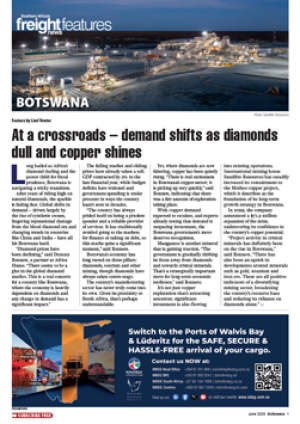Uneven loading and wrong vehicles cause problems, writes Alan Peat
OVERLOADING IS now a major focus for traffic authorities round the country, and the weighbridge at the entrance to the Port of Durban's container terminal is becoming an overload trap for hundreds of container-carrying truckers every month.
But this raises a couple of questions.
Container transport orders (CTOs) for road carriers should have the correct gross weight of the box and its contents appended in pride of place. So why are so many transporters being booked for overloading offences when the weighbridge is now a well-known fixture, and they should know exactly how much their vehicle unit is allowed to carry - and certainly how much they are carrying?
The main answer is that
a large percentage of those getting booked are charged not with simple gross overloading - but
get tickets for having
overloads on certain individual axle groups.
But why should transporters have this problem?
There are two possible reasons. The first is that the container is unevenly loaded, and this skewed weight distribution is a natural overload trap waiting to be sprung.
But here, the transporter has a good case for retrieving his fines from the client. As he cannot be held responsible for the load distribution within a sealed container, these tickets can be passed-on to his client.
And the choice then given to that client is, either to load smarter (this can be done on certain commodities ); load less - or continue to pay the tickets.
But there is also another offence where the transporter is at fault - using the wrong vehicle unit for the container size and mass he is to carry.
The question here though, is why is this now such a frequent offence? The Durban trailer fleet has been the same for years - and the traditional 6-metre skeletal trailer is seen on the roads in thousands every day.
To find out, FTW approached Kevin Martin, chief of planning and
control at Freightliner Transport in Durban, and an authority on truck loading capacity.
A major reason for this, he told FTW, is the lack of professionalism in many parts of the industry of today.
Too many transport operators are that in name only but with no qualifications or experience to back this claim up. This, according to Martin, means that, what you don't know, you'll pay for.
Another fact has become glaringly apparent, he added. The present trailers in the fleets servicing the market are, by and large, dinosaurs!
This is not the fault of the client. All he requires is the transporter to carry his container without the hassle of overload tickets.
Is it possible to do so legally?
The answer, said Martin, is a resounding yes.
The transporter can minimise - although not eliminate entirely - the risk of tickets, by upgrading his equipment.
What you don't know you'll pay for, warns truck loading expert
This, Martin added, can be achieved in the following manner:
l Do not load to the maximum design capacity of the trailer. This is designed on a drawing board
and relates to perfectly distributed loads - a practical impossibility in most cases, said Martin.
l Upgrade the existing 6-m skeletals by converting to a sliding bogie to assist in the load distribution.
l Look to the Makzi design to transport 6-m heavy containers in the centre-mount position - that can be loaded/off-loaded without having to re-position the container.
l Differentiate between both container size and weight before allocating equipment. If marginal upgrade the trailer type chosen to minimise risk.
As a guideline, Martin suggests
the following:
6-metre containers
l Gross up-to 22-tons maximum - use a standard skeletal;
l Up to 24.5-t gross - use
a slider skeletal trailer;
l Up to 26-t - use a Makzi trailer.
12 metre containers
l Gross up to 24-t - use a standard 12-m tandem
trailer;
l Up to 28-t gross - use a standard 12-m triaxle trailer. (We are busy, designing a 12-m triaxle to increase this to 30-t gross.)
Said Martin: The way that container transport has been costed in the past is rapidly changing.
It will, in future, be costed on the basis of standard rate plus a surcharge for upgraded equipment. That is, the weight of the container will dictate what type of equipment has to be chosen, and this will determine the price.
Copyright Now Media (Pty) Ltd
No article may be reproduced without the written permission of the editor
To respond to this article send your email to joyo@nowmedia.co.za
